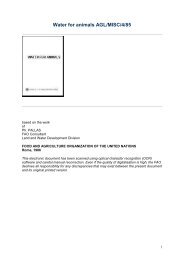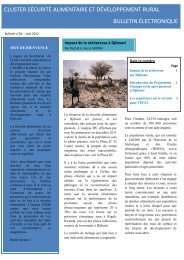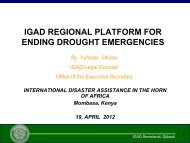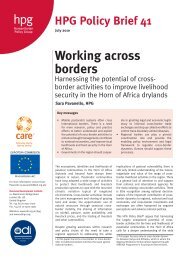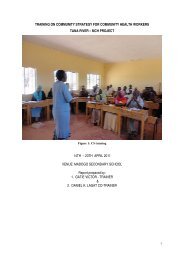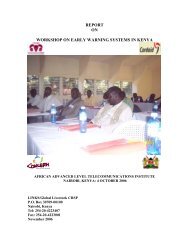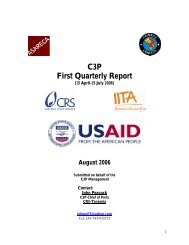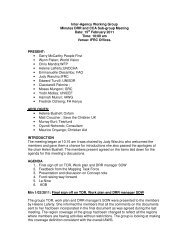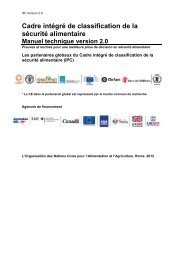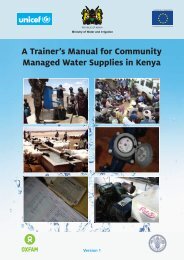The Derg regimePrior to <strong>the</strong> 1970s, not much attenti<strong>on</strong> was given to pastoral regi<strong>on</strong>s in terms <str<strong>on</strong>g>of</str<strong>on</strong>g> sustaining <str<strong>on</strong>g>and</str<strong>on</strong>g>protecting livelihoods, <str<strong>on</strong>g>and</str<strong>on</strong>g> interventi<strong>on</strong>s c<strong>on</strong>centrated almost solely <strong>on</strong> developing l<str<strong>on</strong>g>and</str<strong>on</strong>g> forcommercial irrigated agriculture al<strong>on</strong>g rivers. Measures <str<strong>on</strong>g>and</str<strong>on</strong>g> policies implemented under <strong>the</strong> Dergregime (1974 to 1991), however, left a lasting impact <strong>on</strong> l<str<strong>on</strong>g>and</str<strong>on</strong>g> <str<strong>on</strong>g>and</str<strong>on</strong>g> people in <strong>the</strong> rangel<str<strong>on</strong>g>and</str<strong>on</strong>g>s. The mostimportant <str<strong>on</strong>g>of</str<strong>on</strong>g> <strong>the</strong>se include: 1) <strong>the</strong> ban 16 <strong>on</strong> using c<strong>on</strong>trolled burning 17 to manage <strong>the</strong> rangel<str<strong>on</strong>g>and</str<strong>on</strong>g>s,which saw an increase in bush encroachment <str<strong>on</strong>g>and</str<strong>on</strong>g> shrinkage <str<strong>on</strong>g>of</str<strong>on</strong>g> l<str<strong>on</strong>g>and</str<strong>on</strong>g> usable for grazing; 2) <strong>the</strong>aggressive promoti<strong>on</strong> <str<strong>on</strong>g>of</str<strong>on</strong>g> agricultural expansi<strong>on</strong>, which also reduced <strong>the</strong> extent <str<strong>on</strong>g>of</str<strong>on</strong>g> <strong>the</strong> range; 3) <strong>the</strong>creati<strong>on</strong> <str<strong>on</strong>g>of</str<strong>on</strong>g> Peasant Associati<strong>on</strong>s (PAs) as lowest level <str<strong>on</strong>g>of</str<strong>on</strong>g>ficial administrative units 18 ; 4) <strong>the</strong>enforcement <str<strong>on</strong>g>of</str<strong>on</strong>g> policies to sedentarize pastoralists (Kamara et al, 2003); <str<strong>on</strong>g>and</str<strong>on</strong>g> 5) l<str<strong>on</strong>g>and</str<strong>on</strong>g> nati<strong>on</strong>alizati<strong>on</strong>in <strong>the</strong> highl<str<strong>on</strong>g>and</str<strong>on</strong>g>s.Approaches to rangel<str<strong>on</strong>g>and</str<strong>on</strong>g> development under <strong>the</strong> Derg were top down with soluti<strong>on</strong>s prescribedbased <strong>on</strong> what was believed ‘best’ for <strong>the</strong> rangel<str<strong>on</strong>g>and</str<strong>on</strong>g>s <str<strong>on</strong>g>and</str<strong>on</strong>g> in turn for pastoralists, with littleparticipati<strong>on</strong> from <strong>the</strong> grassroots. The 1975 Nati<strong>on</strong>alizati<strong>on</strong> <str<strong>on</strong>g>of</str<strong>on</strong>g> Rural L<str<strong>on</strong>g>and</str<strong>on</strong>g>s Proclamati<strong>on</strong> states that“<strong>the</strong> government shall have <strong>the</strong> resp<strong>on</strong>sibility to improve grazing areas, to dig wells <str<strong>on</strong>g>and</str<strong>on</strong>g> to settle <strong>the</strong>nomadic people for farming purposes” <str<strong>on</strong>g>and</str<strong>on</strong>g> that nomadic associati<strong>on</strong>s were “to induce <strong>the</strong> nomads tocooperate in <strong>the</strong> use <str<strong>on</strong>g>of</str<strong>on</strong>g> grazing <str<strong>on</strong>g>and</str<strong>on</strong>g> water rights” (in Hogg, 1993: 30). Even though <strong>the</strong> 1975 L<str<strong>on</strong>g>and</str<strong>on</strong>g>Reform in principle granted pastoralists rights to access grazing l<str<strong>on</strong>g>and</str<strong>on</strong>g>, <strong>the</strong>ir priorities came sec<strong>on</strong>d tothose <str<strong>on</strong>g>of</str<strong>on</strong>g> <strong>the</strong> state (Elias, 2008). The Reform nati<strong>on</strong>alised all commercial agricultural c<strong>on</strong>cessi<strong>on</strong>sgranted under <strong>the</strong> emperor Haile Selassie, <str<strong>on</strong>g>and</str<strong>on</strong>g> <strong>the</strong> regime aggressively pursued <strong>the</strong> expansi<strong>on</strong> <str<strong>on</strong>g>of</str<strong>on</strong>g> statefarms with special support provided for agricultural development. Choice areas set aside for stateirrigati<strong>on</strong> projects <str<strong>on</strong>g>of</str<strong>on</strong>g>ten lay in key pastoral dry seas<strong>on</strong> grazing areas which were essential for livestocksurvival in times <str<strong>on</strong>g>of</str<strong>on</strong>g> drought (Hell<str<strong>on</strong>g>and</str<strong>on</strong>g>, 2006).The establishment <str<strong>on</strong>g>of</str<strong>on</strong>g> PAs effectively introduced a parallel system <str<strong>on</strong>g>of</str<strong>on</strong>g> natural resource governance in<strong>the</strong> rangel<str<strong>on</strong>g>and</str<strong>on</strong>g>s, al<strong>on</strong>gside customary governance. Where access to l<str<strong>on</strong>g>and</str<strong>on</strong>g> <str<strong>on</strong>g>and</str<strong>on</strong>g> water resources werepreviously negotiated between different pastoral groups <str<strong>on</strong>g>and</str<strong>on</strong>g> boundaries between <strong>the</strong>m were ‘fuzzy’to accommodate for mobility, PA boundaries “legitimized <str<strong>on</strong>g>and</str<strong>on</strong>g> hardened clan-based claims to l<str<strong>on</strong>g>and</str<strong>on</strong>g><str<strong>on</strong>g>and</str<strong>on</strong>g> water resources” as PA boundaries were loosely based <strong>on</strong> maadda boundaries in Borana <str<strong>on</strong>g>and</str<strong>on</strong>g> <strong>on</strong><strong>the</strong> home areas <str<strong>on</strong>g>of</str<strong>on</strong>g> Somali sub-clans in Somali regi<strong>on</strong> (Hogg, 1997). PA chairmen, usually <str<strong>on</strong>g>of</str<strong>on</strong>g>ficials with<strong>the</strong> received wisdom <str<strong>on</strong>g>of</str<strong>on</strong>g> <strong>the</strong> agricultural highl<str<strong>on</strong>g>and</str<strong>on</strong>g>s, had little knowledge or appreciati<strong>on</strong> for traditi<strong>on</strong>all<str<strong>on</strong>g>and</str<strong>on</strong>g> management systems already in place, or for <strong>the</strong> logic behind <strong>the</strong>se systems, <str<strong>on</strong>g>and</str<strong>on</strong>g> were vestedwith <strong>the</strong> authority to allocate l<str<strong>on</strong>g>and</str<strong>on</strong>g>, preside over issues related to resource use, <str<strong>on</strong>g>and</str<strong>on</strong>g> make decisi<strong>on</strong>s<strong>on</strong> water rights, effectively replacing <strong>the</strong> role <str<strong>on</strong>g>of</str<strong>on</strong>g> traditi<strong>on</strong>al elders (Kamara, 2003). It is <strong>the</strong>reforeunsurprising that agriculture was actively promoted.The overlap <str<strong>on</strong>g>of</str<strong>on</strong>g>, <str<strong>on</strong>g>and</str<strong>on</strong>g> <str<strong>on</strong>g>of</str<strong>on</strong>g>ten c<strong>on</strong>flicts between, <str<strong>on</strong>g>of</str<strong>on</strong>g>ficial <str<strong>on</strong>g>and</str<strong>on</strong>g> customary governance systems weakened<strong>the</strong> authority <str<strong>on</strong>g>of</str<strong>on</strong>g> pastoral elders. As traditi<strong>on</strong>al decisi<strong>on</strong>s <strong>on</strong> l<str<strong>on</strong>g>and</str<strong>on</strong>g> <str<strong>on</strong>g>and</str<strong>on</strong>g> water use did not hold sway in<strong>the</strong> <str<strong>on</strong>g>of</str<strong>on</strong>g>ficial arena, individual pastoralists (<str<strong>on</strong>g>and</str<strong>on</strong>g> n<strong>on</strong>-pastoralists) could disregard <strong>the</strong> codes <str<strong>on</strong>g>and</str<strong>on</strong>g>decisi<strong>on</strong>s <str<strong>on</strong>g>of</str<strong>on</strong>g> customary instituti<strong>on</strong>s <str<strong>on</strong>g>and</str<strong>on</strong>g> seek potentially more favourable outcomes from PAauthorities (S<str<strong>on</strong>g>and</str<strong>on</strong>g>ford, 1983; Tache, 2000). This dual l<str<strong>on</strong>g>and</str<strong>on</strong>g> management system, in effect, made spacefor <strong>the</strong> excepti<strong>on</strong> to dominate <strong>the</strong> rule, <str<strong>on</strong>g>and</str<strong>on</strong>g> individuals (pastoralists <str<strong>on</strong>g>and</str<strong>on</strong>g> n<strong>on</strong>-pastoralists) could nowbenefit or manoeuvre at <strong>the</strong> expense <str<strong>on</strong>g>of</str<strong>on</strong>g> <strong>the</strong> wider community. Also with communal tenure not beingformalized, <str<strong>on</strong>g>and</str<strong>on</strong>g> <strong>the</strong> c<strong>on</strong>tinued appropriati<strong>on</strong> <str<strong>on</strong>g>of</str<strong>on</strong>g> grazing l<str<strong>on</strong>g>and</str<strong>on</strong>g> for farming <str<strong>on</strong>g>and</str<strong>on</strong>g> irrigati<strong>on</strong>, a comm<strong>on</strong>16 This ban was enforced across regi<strong>on</strong>s but was not based <strong>on</strong> any <str<strong>on</strong>g>of</str<strong>on</strong>g>ficial legislati<strong>on</strong> or policy but ra<strong>the</strong>r <strong>on</strong>what was perceived as ‘correct’ l<str<strong>on</strong>g>and</str<strong>on</strong>g> management practice at <strong>the</strong> time.17 A traditi<strong>on</strong>al l<str<strong>on</strong>g>and</str<strong>on</strong>g> management practice used by pastoralists.18 Similar to today’s kebeles.30
observed resp<strong>on</strong>se was for individuals to seek new ways <str<strong>on</strong>g>of</str<strong>on</strong>g> ensuring access to rangel<str<strong>on</strong>g>and</str<strong>on</strong>g>s, whichincluded <strong>the</strong> creati<strong>on</strong> <str<strong>on</strong>g>of</str<strong>on</strong>g> private reserves for different purposes within <strong>the</strong> comm<strong>on</strong>s (Hell<str<strong>on</strong>g>and</str<strong>on</strong>g>, 2006).Water development under <strong>the</strong> DergThe Rangel<str<strong>on</strong>g>and</str<strong>on</strong>g>s Development Project (RDP) 19 , initiated in 1975 <str<strong>on</strong>g>and</str<strong>on</strong>g> funded by <strong>the</strong> government <str<strong>on</strong>g>and</str<strong>on</strong>g><strong>the</strong> World Bank, was c<strong>on</strong>sidered <strong>the</strong> first large scale range improvement effort by government <str<strong>on</strong>g>and</str<strong>on</strong>g>d<strong>on</strong>ors. The development <str<strong>on</strong>g>of</str<strong>on</strong>g> water infrastructure was a central feature. The RDP is c<strong>on</strong>sidered a keyproject am<strong>on</strong>g water development practiti<strong>on</strong>ers in Ethiopia (across <strong>the</strong> spectrum from governmentto n<strong>on</strong>-government) which illustrates what not to do in terms <str<strong>on</strong>g>of</str<strong>on</strong>g> water development in <strong>the</strong>rangel<str<strong>on</strong>g>and</str<strong>on</strong>g>s.The RDP aimed to “restructure low output traditi<strong>on</strong>al range practices <str<strong>on</strong>g>and</str<strong>on</strong>g> improve efficiency <str<strong>on</strong>g>of</str<strong>on</strong>g>producti<strong>on</strong>” (World Bank, 1991), <str<strong>on</strong>g>and</str<strong>on</strong>g> <strong>the</strong>refore promoted ranching <str<strong>on</strong>g>and</str<strong>on</strong>g> settled forms <str<strong>on</strong>g>of</str<strong>on</strong>g> livestockproducti<strong>on</strong> as a soluti<strong>on</strong> to <strong>the</strong> perceived irrati<strong>on</strong>al <str<strong>on</strong>g>and</str<strong>on</strong>g> unproductive pastoral use <str<strong>on</strong>g>of</str<strong>on</strong>g> <strong>the</strong> rangel<str<strong>on</strong>g>and</str<strong>on</strong>g>s(Hogg, 1993). In essence, <strong>the</strong> project did not recognize <strong>the</strong> productivity <str<strong>on</strong>g>of</str<strong>on</strong>g> mobile livestockproducti<strong>on</strong> systems. The World Bank completi<strong>on</strong> report published in 1991 admitted that <strong>the</strong>re wasa lack <str<strong>on</strong>g>of</str<strong>on</strong>g> knowledge <str<strong>on</strong>g>of</str<strong>on</strong>g> pastoralists’ behaviour <str<strong>on</strong>g>and</str<strong>on</strong>g> <strong>the</strong> drivers behind traditi<strong>on</strong>al l<str<strong>on</strong>g>and</str<strong>on</strong>g> use practices.The c<strong>on</strong>structi<strong>on</strong> <str<strong>on</strong>g>of</str<strong>on</strong>g> water points was <strong>on</strong>e <str<strong>on</strong>g>of</str<strong>on</strong>g> <strong>the</strong> <strong>on</strong>ly comp<strong>on</strong>ents <str<strong>on</strong>g>of</str<strong>on</strong>g> <strong>the</strong> project where headwaywas made. Boreholes were c<strong>on</strong>structed <strong>on</strong> ranches where water catchment was restricted, <str<strong>on</strong>g>and</str<strong>on</strong>g>p<strong>on</strong>ds proliferated in wet <str<strong>on</strong>g>and</str<strong>on</strong>g> dry seas<strong>on</strong> grazing areas. The project rati<strong>on</strong>ale for water pointc<strong>on</strong>structi<strong>on</strong> in wet seas<strong>on</strong> grazing areas was that it would open up <str<strong>on</strong>g>and</str<strong>on</strong>g> allow more ‘efficient’ use <str<strong>on</strong>g>of</str<strong>on</strong>g>pasture in <strong>the</strong>se areas to reduce pressure <strong>on</strong> dry seas<strong>on</strong> grazing areas (Gebre Mariam, 1982). Largep<strong>on</strong>ds were also c<strong>on</strong>structed in dry seas<strong>on</strong> grazing areas (World Bank, 1991).The RDP inserted water points in pastoral areas with little underst<str<strong>on</strong>g>and</str<strong>on</strong>g>ing <str<strong>on</strong>g>of</str<strong>on</strong>g> pastoral dynamics <str<strong>on</strong>g>and</str<strong>on</strong>g><strong>the</strong> logic behind pastoral natural resource management strategies. The project did not take <strong>on</strong> boardwhat local people c<strong>on</strong>sidered appropriate, <str<strong>on</strong>g>and</str<strong>on</strong>g> water points were planned <str<strong>on</strong>g>and</str<strong>on</strong>g> c<strong>on</strong>structed in a topdownfashi<strong>on</strong> by technical pers<strong>on</strong>s with little participati<strong>on</strong> from <strong>the</strong> grassroots. Water points werealso government owned, <str<strong>on</strong>g>and</str<strong>on</strong>g> management <str<strong>on</strong>g>and</str<strong>on</strong>g> maintenance were <strong>the</strong> ultimate resp<strong>on</strong>sibility <str<strong>on</strong>g>of</str<strong>on</strong>g> localadministrati<strong>on</strong>. Therefore, project water points were completely external to traditi<strong>on</strong>al systems,which brought with it a loss <str<strong>on</strong>g>of</str<strong>on</strong>g> c<strong>on</strong>trol over who, how many, <str<strong>on</strong>g>and</str<strong>on</strong>g> when people <str<strong>on</strong>g>and</str<strong>on</strong>g> livestock hadaccess to grazing l<str<strong>on</strong>g>and</str<strong>on</strong>g>. In additi<strong>on</strong>, <strong>the</strong> <str<strong>on</strong>g>of</str<strong>on</strong>g>ten weak management capacity by local administrati<strong>on</strong> sawc<strong>on</strong>flict arise at <strong>the</strong> grassroots over c<strong>on</strong>trol <str<strong>on</strong>g>and</str<strong>on</strong>g> access to water points, <str<strong>on</strong>g>and</str<strong>on</strong>g> many <str<strong>on</strong>g>of</str<strong>on</strong>g> <strong>the</strong> waterpoints c<strong>on</strong>structed at <strong>the</strong> time fell into disrepair.Assessments <str<strong>on</strong>g>of</str<strong>on</strong>g> <strong>the</strong> project reflected <strong>on</strong> some <str<strong>on</strong>g>of</str<strong>on</strong>g> <strong>the</strong> impacts <str<strong>on</strong>g>of</str<strong>on</strong>g> water point development:• N<strong>on</strong>-local ownership <str<strong>on</strong>g>and</str<strong>on</strong>g> management resp<strong>on</strong>sibility <str<strong>on</strong>g>of</str<strong>on</strong>g> water points resulted in poorlyc<strong>on</strong>trolled access <str<strong>on</strong>g>and</str<strong>on</strong>g> poor maintenance. S<str<strong>on</strong>g>and</str<strong>on</strong>g>ford (1983: 29) states that <strong>the</strong> government’sclaimed right to c<strong>on</strong>trol access to water points meant that “additi<strong>on</strong>al people who wouldo<strong>the</strong>rwise have been excluded from water points giving access to certain grazing areas are nowallowed in.” Points were also <str<strong>on</strong>g>of</str<strong>on</strong>g>ten inadequately sited <str<strong>on</strong>g>and</str<strong>on</strong>g> inappropriately spaced.• The c<strong>on</strong>structi<strong>on</strong> <str<strong>on</strong>g>of</str<strong>on</strong>g> large p<strong>on</strong>ds encouraged permanent settlement so that people could nowmake year-round use <str<strong>on</strong>g>of</str<strong>on</strong>g> surrounding pasture. Overgrazing <str<strong>on</strong>g>and</str<strong>on</strong>g> erosi<strong>on</strong> (pasture degradati<strong>on</strong>)were frequently observed around large capacity water points. Alternative modes <str<strong>on</strong>g>of</str<strong>on</strong>g> producti<strong>on</strong>,such as small-scale crop cultivati<strong>on</strong>, also began to appear with <strong>the</strong> year-round availability <str<strong>on</strong>g>of</str<strong>on</strong>g>water, introducing a competing l<str<strong>on</strong>g>and</str<strong>on</strong>g> use in predominantly rangel<str<strong>on</strong>g>and</str<strong>on</strong>g> areas (Gebre Mariam 1982).19 Implemented through <strong>the</strong> Sou<strong>the</strong>rn Rangel<str<strong>on</strong>g>and</str<strong>on</strong>g>s Development Unit (SORDU), <strong>the</strong> Jijiga Rangel<str<strong>on</strong>g>and</str<strong>on</strong>g>sDevelopment Unit (JIRDU), <str<strong>on</strong>g>and</str<strong>on</strong>g> <strong>the</strong> Nor<strong>the</strong>ast Rangel<str<strong>on</strong>g>and</str<strong>on</strong>g>s Development Unit (NERDU).31
- Page 1 and 2: Synthesis
- Page 4 and 5: TABLE OF CONTENTSLIST OF ACRONYMS..
- Page 6 and 7: ACKNOWLEDGMENTSI would like to exte
- Page 8 and 9: LIST OF ACRONYMSACDI/VOCAACFAFDCDDC
- Page 10 and 11: EXECUTIVE SUMMARYWater development
- Page 12 and 13: understanding <str
- Page 14 and 15: Agreed upon guidelines for water de
- Page 16 and 17: • Make better use of</str
- Page 18 and 19: to inform their own work an
- Page 20 and 21: Within pastoral areas, it is recogn
- Page 23 and 24: Section 2. Overview of</str
- Page 25 and 26: Dohrn, 2006). Spatially variable ra
- Page 27 and 28: The following broad overview touche
- Page 29: In areas of adequa
- Page 33 and 34: Specific to water development, seve
- Page 35 and 36: Section 3. Water development todayT
- Page 37 and 38: Eliciting payments for water from l
- Page 39 and 40: ureaus 25 . The ministry’s interv
- Page 41 and 42: National policy paints a conflictin
- Page 43 and 44: will be given to pastoralists to en
- Page 45 and 46: Water supplyGovernance and<
- Page 47 and 48: vulnerable to conversion for other
- Page 49 and 50: • Agro-pastoralists’ priorities
- Page 51 and 52: Although the WSDP principles are se
- Page 53 and 54: The Universal Access ProgramThe Uni
- Page 55 and 56: • Help ensure that public works d
- Page 57 and 58: However, the development model for
- Page 59 and 60: Figure 4: Proposed pilot la
- Page 61 and 62: Many international and</str
- Page 63 and 64: Furthermore, attention is given to
- Page 65 and 66: CARE International, under the GWI,
- Page 67: and traditional me
- Page 70 and 71: • Understand exi
- Page 72 and 73: 4.2 Key observations in the water d
- Page 74 and 75: epresent a firm attempt to preserve
- Page 76 and 77: learning from NGO experiences in Bo
- Page 78 and 79: However, there are currently no spe
- Page 80 and 81:
4.3 Conclusion, ways forward <stron
- Page 82 and 83:
In sum, pastoralism as a livelihood
- Page 84 and 85:
• Water interventions selected sh
- Page 86 and 87:
• Promote effective participation
- Page 88 and 89:
Gebre-Mariam, A. (1982). Organizati
- Page 90:
Schimann P. and Ph



